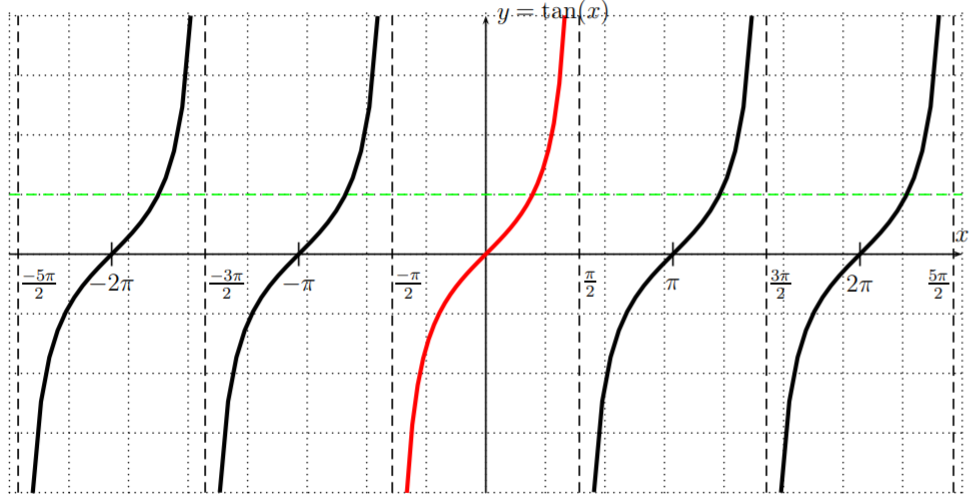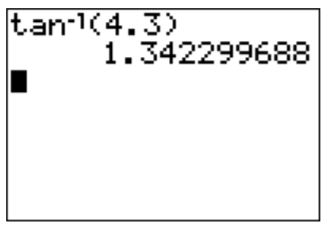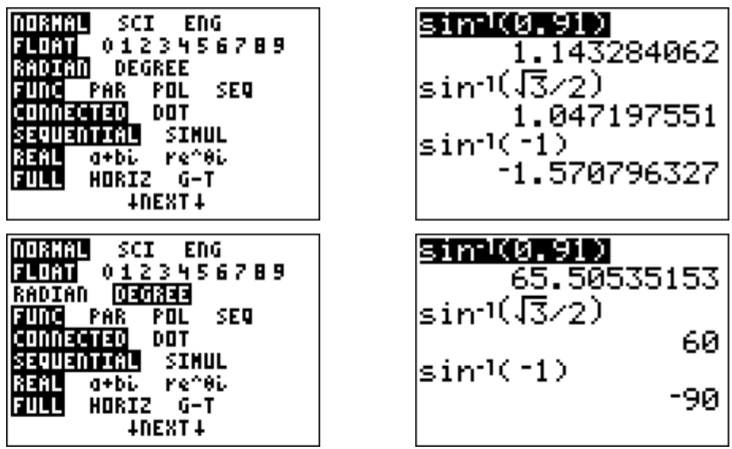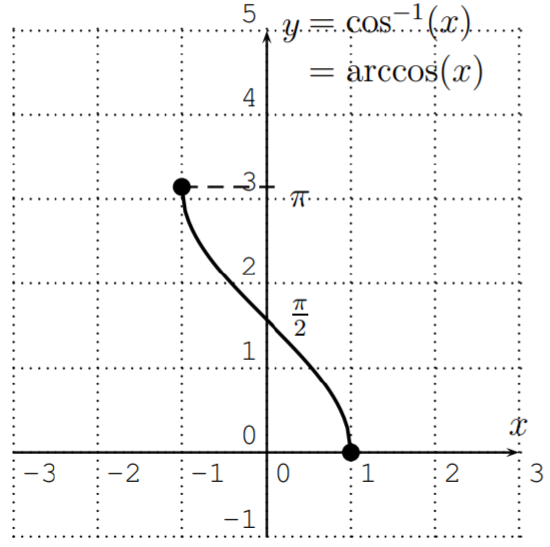19.1: The functions of arcsin, arccos, and arctan
( \newcommand{\kernel}{\mathrm{null}\,}\)
The inverse trigonometric functions are the inverse functions of the y=sinx, y=cosx, and y=tanx functions restricted to appropriate domains. In this section we give a precise definition of these functions.
The Inverse Tangent Function
We start with the inverse to the tangent function y=tan(x). Recall that the graph of y=tan(x) is the following:

It has vertical asymptotes at x=±π2,±3π2,±5π2,…. Note, that y=tan(x) is not a one-to-one function in the sense of defintion [DEF:1-to-1] on page . (For example, the horizontal line y=1 intersects the graph at x=π4, x=π4±π, x=π4±2π, etc.) However, when we restrict the function to the domain D=(−π2,π2) the restricted function is one-to-one, and, for this restricted function, we may take its inverse function.
The inverse of the function y=tan(x) with restricted domain D=(−π2,π2) and range R=R is called the inverse tangent or arctangent function. It is denoted by
y=tan−1(x) or y=arctan(x)⟺tan(y)=x,y∈(−π2,π2)
The arctangent reverses the input and output of the tangent function, so that the arctangent has domain D=R and range R=(−π2,π2). The graph is displayed below.

The notation of tan−1(x) and tan2(x) is slightly inconsistent, since the exponentiation symbol is used above in two different ways. In fact, tan−1(x)=arctan(x) refers to the inverse function of the tan(x) function. However, when we write tan2(x), we mean
tan2(x)=(tan(x))2=tan(x)⋅tan(x)
Therefore, tan−1(x) is the inverse function of tan(x) with respect to the composition operation, whereas tan2(x) is the square with respect to the usual product in R. Note also that the inverse function of the tangent with respect to the product in R is y=1tan(x)=cot(x), which is the cotangent.
The next example calculates function values of the inverse tangent function.
Recall the exact values of the tangent function from section 17.1:
x0=0∘π6=30∘π4=45∘π3=60∘π2=90∘tan(x)0√331√3 undef.
Solution
From this, we can deduce function values by reversing inputs and outputs, such as:
tan(π6)=√33⟹tan−1(√33)=π6tan(π4)=1⟹tan−1(1)=π4
Also, since tan−1(−x)=−tan−1(x), we obtain the inverse tangent of negative numbers.
tan−1(−√3)=−tan−1(√3)=−π3tan−1(−1)=−tan−1(1)=−π4
We may calculate the inverse tangent of specific values with the calculator using the 2nd and tan keys. For example, tan−1(4.3)≈1.34.

Note, that the answer differs, when changing the mode from radians to degree, since tan−1(4.3)≈76.9∘≈1.34.

The function y=sin−1(x)
Next, we define the inverse sine function. For this, we again first recall the graph of the y=sin(x) function, and note that it is also not one-to-one.

However, when restricting the sine to the domain [−π2,π2], the restricted function is one-to-one. Note furthermore, that when restricting the domain to [−π2,π2], the range is [−1,1], and therefore we cannot extend this to a larger domain in a way such that the function remains a one-to-one function. We use the domain [−π2,π2] to define the inverse sine function.
The inverse of the function y=sin(x) with restricted domain D=[−π2,π2] and range R=[−1,1] is called the inverse sine or arcsine function. It is denoted by
y=sin−1(x) or y=arcsin(x)⟺sin(y)=x,y∈[−π2,π2]
The arcsine reverses the input and output of the sine function, so that the arcsine has domain D=[−1,1] and range R=[−π2,π2]. The graph of the arcsine is drawn below.

The inverse sine function is odd:
sin−1(−x)=−sin−1(x)
This can again be seen by observing that the sine y=sin(x) is an odd function (that is sin(−x)=−sin(x)), or alternatively directly from the symmetry of the graph with respect to the origin (0,0).
We now calculate specific function values of the inverse sine.
We first recall the known values of the sine.
x0=0∘π6=30∘π4=45∘π3=60∘π2=90∘sin(x)012√22√321
Solution
These values together with the fact that the inverse sine is odd, that is sin−1(−x)=−sin−1(x), provides us with examples of its function values.
sin−1(√22)=π4sin−1(1)=π2sin−1(0)=0sin−1(−12)=−sin−1(12)=−π6
Note, that the domain of y=sin−1(x) is D=[−1,1], so that input numbers that are not in this interval give undefined outputs of the inverse sine:
sin−1(3) is undefined
Input values that are not in the above table may be found with the calculator via the 2ndsin keys. We point out, that the output values depend on wether the calculator is set to radian or degree mode. (Recall that the mode may be changed via the key).

The function y=cos−1(x)
Finally, we define the inverse cosine. Recall the graph of y=cos(x), and note again that the function is not one-to-one.

In this case, the way to restrict the cosine to a one-to-one function is not as clear as in the previous cases for the sine and tangent. By convention, the cosine is restricted to the domain [0,π]. This provides a function that is one-to-one, which is used to define the inverse cosine.
The inverse of the function y=cos(x) with restricted domain D=[0,π] and range R=[−1,1] is called the inverse cosine or arccosine function. It is denoted by
y=cos−1(x) or y=arccos(x)⟺cos(y)=x,y∈[0,π]
The arccosine reverses the input and output of the cosine function, so that the arccosine has domain D=[−1,1] and range R=[0,π]. The graph of the arccosine is drawn below.

The inverse cosine function is neither even nor odd. That is, the function cos−1(−x) cannot be computed by simply taking ±cos−1(x). But it does have some symmetry given algebraically by the more complicated relation
cos−1(−x)=π−cos−1(x)
- Proof
-
We can see that if we shift the graph down by π2 the resulting function is odd. That is to say the function with the rule cos−1(x)−π2 is odd:
cos−1(−x)−π2=−(cos−1(x)−π2)
which yields ??? upon distributing and adding π2.
Another, more formal approach is as follows. The bottom right relation of [EQU:basic-trig-eqns-wrt-pi] on page states, that we have the relation cos(π−y)=−cos(y) for all y. Let −1≤x≤1, and denote by y=cos−1(x). That is y is the number 0≤y≤π with cos(y)=x. Then we have
−x=−cos(y)=cos(π−y) (by equation 17.1.2)
Applying cos−1 to both sides gives:
cos−1(−x)=cos−1(cos(π−y))=π−y
The last equality follows, since cos and cos−1 are inverse to each other, and 0≤y≤π, so that 0≤π−y≤π are also in the range of the cos−1. Rewriting y=cos−1(x) gives the wanted result:
cos−1(−x)=π−cos−1(x)
This is the equation ??? which we wanted to prove.
We now calculate specific function values of the inverse cosine.
We first recall the known values of the cosine.
x0=0∘π6=30∘π4=45∘π3=60∘π2=90∘cos(x)1√32√22120
Solution
Here are some examples for function values of the inverse cosine.
cos−1(√32)=π6,cos−1(1)=0,cos−1(0)=π2
Negative inputs to the arccosine can be calculated with equation ???, that is cos−1(−x)=π−cos−1(x), or by going back to the unit circle definition.
cos−1(−12)=π−cos−1(12)=π−π3=3π−π3=2π3cos−1(−1)=π−cos−1(1)=π−0=π
Furthermore, the domain of y=cos−1(x) is D=[−1,1], so that input numbers not in this interval give undefined outputs of the inverse cosine.
cos−1(17) is undefined
Other input values can be obtained with the calculator by pressing the 2ndcos keys. For example, we obtain the following function values (here using radian measure).



